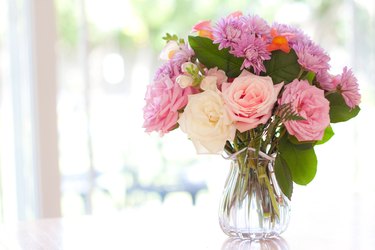The days when you could actually buy something with a few pennies are long gone, and the rise of online shopping and phone-based payment — and therefore, a drop in opportunities to pay with cash — mean ever fewer opportunities to spend them. While some argue for doing away with the penny entirely, as the Canadians did years ago, it still has plenty of uses beyond the simply financial. Here are a handful of fun and functional uses for pennies that might not have occurred to you.

Video of the Day
1. Chill With a Penny-Filled Cold Compress
One of the most useful things about copper is how well it transmits heat. That's why it's traditionally used in pots and pans, whether inside stainless steel cladding to help heat distribute evenly, or on the outside where it adds beauty as well. You won't make your own pots and pans out of pennies, but their ability to conduct heat makes them a great filling for a cold compress. You can freeze them inside a conventional ice pack if you have one, sew them into a fabric bag for permanent use, or in a pinch just drop them into a zippered plastic bag for use on strains, sprains, or dull headaches.
Video of the Day

2. Keep Your Drapes Hanging Neatly
Long, gauzy drapes lend an elegant look to any room, but not if they wrinkle or won't hang straight. Sewing a few pennies into the bottom seam will give them just enough weight to hang neatly and drape beautifully when tied back. As a bonus, they'll keep your drapes from billowing quite so much if the window is open. If sewing isn't your thing, iron-on bias tapes or even hot glue will work in a pinch. The same trick works beautifully to weight down the edges of outdoor tablecloths on your deck or patio, so they won't blow around in the breeze.

3. Forget Penny Tile, and Use Actual Pennies
If you watch a lot of home design or renovation shows, you'll know that designers love to use small, round "penny tile" as a classical and timeless flooring choice. The term refers to conventional ceramic tiles about the diameter of a penny, but there's no reason you can't use actual pennies instead. It takes about 300 of them for a square foot of flooring, or roughly $3 per square foot before adhesives and grout, which is pretty reasonable. You can apply them directly to a prepared surface one at a time, but that's a slog. It's smarter to glue them to a mesh backing, one square foot at a time (like commercial tiles) and then lay the floor once you've prepared enough squares.
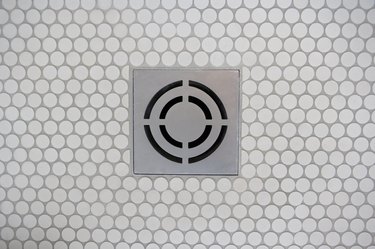
4. Use Pennies as Spacers
If you opt to use real tile for your floors and backsplashes instead of pennies, that's fine too. After all, conventional tile gives you a lot more options for size, shape and color. That doesn't mean you can't still use pennies, though. When you're setting tile it's always good to have spacers between the individual tiles to keep them even and square, and leave consistent grout lines. You could buy bags of them at your building-supplies store, or you could substitute the pennies you already have lying around the house collecting dust. Only one of those options involves making another trip to the store to spend money, so it's not a hard choice.

5. "De-Wobble" Your Furniture
In an ideal world, tables and chairs would stand squarely on their own four feet, and never wobble a bit. This isn't an ideal world, of course, and whether it's the fault of the furniture or a floor that's out of level, tables and chairs that rock are a pretty frequent occurrence. What you need to level them is some kind of thin shim that's sturdy enough to take the furniture's weight without complaint. Something like...you know...a penny. For a quick, temporary fix, just slide a penny under the short leg of your table or chair to level it out. For bigger wobbles, tape two or three pennies together. Don't use them on hardwood, though, which could be scratched by the copper.

6. Use Them as Craft/DIY Materials
If doing an entire floor in pennies just seems like too much work, you can apply the same basic technique to make a durable and decorative tabletop, backsplash, or bar counter in your home. Just glue down the pennies, seal them in epoxy or polyurethane, and enjoy them for years. Cleaned up, they can make appealing copper jewelry or buttons for clothing and furniture. You can also use pennies — cleaned or tarnished, depending on the effect you're looking for — to decorate lamps or chandeliers, make a border around your artworks, or even create mosaics out of the pennies themselves by sorting them for color and making designs.
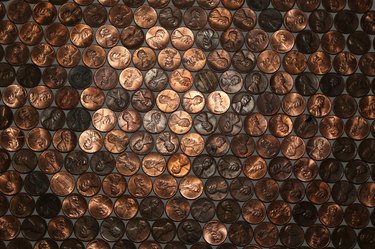
7. Make a Convenient (and Inexpensive) Door Stop
Life is filled with moments when two hands just aren't enough. Often that's when you're unloading the car after a shopping trip, or loading up the car for a road trip, or any other time you're passing through the same door repeatedly. Rather than juggling your bags and packages awkwardly as you reach for the knob, it's much easier to simply prop the door open with a convenient doorstop. It doesn't have to be fancy; just a simple canvas bag filled with pennies will work perfectly. If you dress it up with a ribbon and some hand-stitching, it can even double as a "rustic" decoration on a nearby windowsill or piece of furniture.
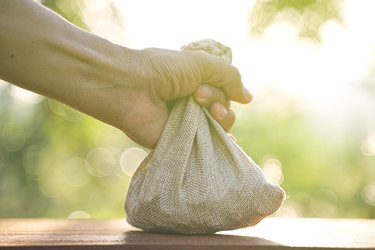
8. Reuse Them as Washers
Almost everything held together with bolts, and many things held together with screws, use flat metal washers to help ensure a tight connection. The unfortunate thing with washers is that they're easily lost, which means you may come up short in the middle of reassembling a piece of furniture, or attempting a DIY project. You can leap that hurdle in seconds by digging into your bag of pennies, and drilling a hole in the middle to convert it to a washer. You can create as many washers as you need in just moments, and the cost, of course, is just pennies.
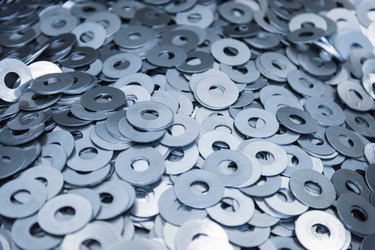
9. Use Them for Science Experiments
A jar of pennies gives you plenty of scope for carrying out science experiments with the kids, as well. A well-known example is the "lemon battery" experiment, with a penny and a galvanized nail inserted into a lemon to create electricity. You can also make a salt-and-vinegar solution and brush it onto clean pennies to create an aged verdigris finish, or drop tarnished pennies into the same solution and watch as the tarnish disappears to leave them shiny and clean. If you drop an iron nail into the same solution afterwards, the copper ions suspended in the solution will gravitate to the nail and copper-plate it. That's pretty cool stuff.

10. Make Flowers Last Longer
Aside from keeping the kids entertained, which is always useful, pennies figure into a bit of "applied science" as well. If you like keeping cut flowers in your home, a penny can help them maintain their beauty for longer. Choose a penny dated from 1982 or earlier, when they were still made from copper, and drop it into the vase along with either a sugar cube or an envelope of commercial cut-flower food. Copper is a natural fungicide, so it will help keep the water gunk-free and your flowers healthy.
